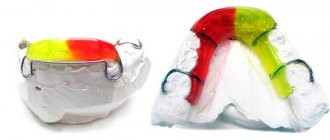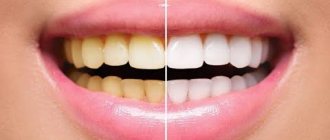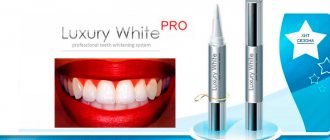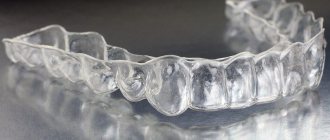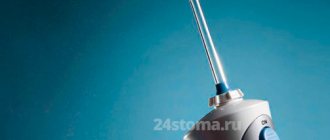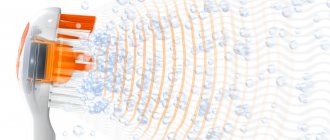Those who have just had braces installed may experience discomfort and pain in the first few days or weeks. This is a normal adaptation process, after which the discomfort will subside. Wax for braces helps minimize discomfort. We’ll tell you in the article how to use it and what to replace it with.
In this article
- Braces design
- Why do you need dental wax with braces?
- Composition of orthodontic wax
- How to use wax for braces?
- How can you choose wax for braces?
- What can replace wax for braces?
- How long to use dental wax?
Is it necessary to carry out hygienic cleaning before installing braces?
If there is evidence for this, then it is necessary, since braces must be installed on clean enamel. It is important that there is no accumulation of plaque underneath them, otherwise caries may develop under the braces. In addition, if there is a lot of plaque, it will be difficult to remove it with braces - it is better to do this before the system is fixed.
However, if you have recently had dental hygiene, it is better to postpone the procedure a little and go through it 2-3 months after installing the braces system - it will be much more effective.
Bottom line
Wax for braces makes it easier for the mucous membrane to get used to the metal elements of the system. Sometimes the adaptation period passes with major injuries, cuts, ulcers, and cracks in the mucous membrane. An unprepared oral cavity suffers from an additional metal element. Sometimes the arc can break and become detached: this also causes injury to the mucous membrane. Wax paste protects from injuries, antimicrobial components protect wounds from suppuration. Some pastes have added wound-healing substances, which ensures rapid tissue restoration.
Sources used:
- Gerasimov S. N. Fixed orthodontic equipment. Publishing house. St. Petersburg State Medical University, 2002
- Proffitt W.R., Modern orthodontics (3rd edition), MEDpress-inform, 2015.
- Borkowski RN The biologically based case for truly light-force mechanics, Clinical Impressions
- Wikipedia article
What products are needed to care for teeth with braces?
Caring for teeth with braces
| Name | Description |
| Various toothbrushes | Braces are placed in stages: first on the upper jaw, after a few weeks or even months - on the lower jaw. Therefore, you can brush your teeth without braces as usual. But for those teeth that have braces attached, it is better to purchase a brush with a V-shaped groove specifically designed for braces. Additionally, thin mono-tuft brushes will be useful, which will allow you to reach narrow and hard-to-reach places and better clean the braces themselves. Try different options - this way you can choose the best and most convenient one for yourself, and your attending physician will evaluate how well you perform hygiene with the chosen products. |
| Toothpaste | After installing braces, teeth often break, the enamel becomes thinner, and the teeth react sharply to external influences. Therefore, a toothpaste for sensitive teeth must be in your arsenal. After the condition of the enamel is normalized, it can be changed to whitening or anti-plaque. Do not forget to change the paste every 3-4 months or even more often, selecting it in accordance with the problems that you have. |
| Interdental brushes and/or dental floss | Use after every meal, carefully cleaning the interdental spaces. Also use brushes under the arch and along the top of the plates - these are places where pieces of food often remain. Choose the product of the desired thickness - start with the thinnest ones and choose the option that is right for you, taking into account the size of the spaces between the teeth. It is better if the kit includes brushes of different sizes - for different intervals. |
| Irrigator | It is not only possible to use it, but also absolutely necessary to clean the interdental spaces. |
| Mouthwash | Choose any one that suits you - you can leave the one you used before installing braces. |
| Protective wax | Buy it on the first day, since braces (their protruding edges and arch) can rub the inside of the cheeks, especially in the first days. |
| Travel set | At first glance, this may seem like a waste of money, but this is a great option for those who travel often or lead an active lifestyle - throw this set in your purse and carry out hygiene after any snack. You can form it yourself by packing all the necessary products in a small cosmetic bag. |
Advantages and disadvantages
The protective product has enough advantages:
- Simplicity and ease of use. You can use the drug anywhere and at any time.
- Ensuring comfortable wearing of the orthodontic mechanism and quick adaptation to it.
- Aesthetic appearance. The absence of any color in the wax does not attract attention.
- Excellent protection - preventing injury and irritation of the mucous membrane.
- Visible result of healing of wounds that appeared before using wax.
- Economical. 1-2 packages are enough for the adaptation period.
- Acceptable cost is around 100–300 rubles.
Disadvantages include:
- the possibility of individual intolerance to some components of the drug;
- a low-quality product quickly dissolves in saliva and any liquid;
- The wax must be removed before eating.
Also, not all manufacturers include instructions for using their product in the packaging, which makes it difficult to use.
Individual intolerance
In general, orthodontic wax is well tolerated. In dental practice, only a few cases of allergies are known, which caused swelling of the mucous membrane.
What to do in these cases?
Due to the presence of such cases, it is recommended to study the composition of the purchased product and check with the seller for information about the availability of a quality certificate for the product.
And also monitor the body’s reaction during the first use. This recommendation especially applies to the use of the drug by children. To avoid allergies, choose wax with a neutral taste and smell (without fragrances or flavoring additives). And if it appears, seek help from your doctor.
You can buy a protective agent at a pharmacy or online store, just before ordering the wax, carefully study the composition and reviews of previous customers. And if the package does not contain instructions for use, then our article will help you resolve this issue.
Can I use an electric toothbrush?
Ultrasonic is not possible, conventional electric is possible. The first can lead to the plates coming off, the second should not have a moving head and strong vibration - this will not harm the braces, but it will be inconvenient for you to use such a brush, since the bristles will get stuck. You can use several toothbrushes at once - a regular one to clean the inner surface of the teeth, and an orthodontic one to clean the outer surface where the braces are located.
“The braces are fixed quite securely - you need to try hard to peel them off the surface of the teeth. Therefore, hygiene must be carried out without fear and in no case reducing its intensity, making allowances for braces. If the care is poor, after removing the system we will find caries and white spots on the enamel.”
Rustamova Gunel Bakhmanovna, dentist-orthodontist, work experience more than 4 years make an appointment
What diet should you follow?
There are three main rules that must be followed after installing braces:
- avoidance of excessively hard and “sticky” foods – nuts, seeds, toffees, chewing gums,
- hard fruits and vegetables, meat must be cut into small pieces, chewing with side teeth,
- food and drinks should be warm, but not hot - this can lead to the records coming off.
Your diet should remain unchanged, with the exception of the three points listed. Do not overuse liquid and soft foods - your teeth must receive stress for normal functioning. You can minimize the consumption of viscous foods (chocolate, waffles, chips) - but not because they are prohibited, but because they accumulate on braces and under the archwire. They will simply be very difficult to remove.
How to eat immediately after getting braces
In the first 1-2 weeks after installing braces (as well as after their activation), especially with a significant defect and the choice of ligature structures (they put more pressure on the teeth than self-ligating ones), you will experience pain. The degree of intensity is completely different and depends on many factors, including your sensitivity. Therefore, if at first you find it painful and unpleasant to eat your usual food, change it to a more liquid one - give preference to soups, dairy products, yoghurts, or puree the main dishes. This will reduce the load on the teeth and reduce painful manifestations.
Rules for daily hygiene care
If you have braces, you should make it a rule to take care of your teeth every day - morning, evening and after every snack. This will help maintain healthy teeth and a snow-white shade of enamel after removing braces.
- Brush your teeth with a brush and toothpaste in the morning and evening. If you have a special brush, it is necessary to carry out horizontal movements along the arch of the braces (there is a recess inside the bristles for the arch). Use a regular brush without strong pressure, using both horizontal and vertical movements. Move the head actively, clean each record separately,
- After the main cleaning, use a single-tuft brush or brushes to clean every gap between the brackets/archwires, the surface of the teeth, as well as the plates themselves, top and bottom. Pay special attention to the brackets that are located on the farthest teeth - it is on them that the largest amount of plaque accumulates, since it is with these elements that we chew food,
- Rinse your mouth with water and mouthwash for 1-2 minutes.
Cleaning can also be supplemented with an irrigator (can also be directed at the plates - the pressure should be reduced only in the presence of ceramic and sapphire systems) and dental floss.
Orthodontic wax and irrigator: additional elements of the standard set
The use of orthodontic wax can significantly reduce the discomfort caused by metal braces.
Very often, protruding elements of the braces system scratch the delicate tissues of the oral cavity. Wax protects gums, inner lips and cheeks from sores and scratches. The wax is sold in small plastic boxes and has a structure similar to soft chewing gum. Using the product is quite simple: you need to tear off a little wax from the container, warm it in your palms, and then apply directly to the lock or bracket that is causing irritation. Don't worry that some of the wax will be accidentally swallowed, because dental products are non-toxic. Another optional, but very useful device designed to make caring for braces easier is an irrigator. This dental device is used to clean the spaces between braces and teeth. The irrigator acts as a small pump that directs a stream of water to the desired location.
Why do my teeth hurt after installing and activating braces?
In the first days after installation, and subsequently after activation of braces, aching sensations of varying degrees of intensity are possible - the stronger the defect, the greater the pain. When fixing ligature systems, the pressure is greater, so the teeth will hurt more. Soreness in general is a completely normal reaction, since braces from the first minutes after fixation already have an impact on the teeth and change their position.
If the pain is severe, then in the first days after installation or activation of the system, you can take painkillers. But no more than 2-3 days. If discomfort persists, contact your orthodontist for system correction.
Are there any contraindications
The wax used in orthodontic practice has a completely safe composition, and therefore is characterized by a minimum number of contraindications. Many people are interested in the question of whether it is possible to sleep with it. Because it is non-toxic, it does not need to be washed off before bed if your braces become chafed while you sleep.
In some cases, the use of this product is not recommended, mainly due to increased sensitivity to individual components included in the composition. Otherwise, the risk of developing an allergic reaction will increase, which can be expressed in the form of itching, swelling, redness of soft tissues and the development of an inflammatory process1. If you observe something similar in yourself, stop using the composition and consult a dentist for advice on eliminating symptoms.
What to do if your braces chafe?
For inflammation of the mucous membranes, you can use special gels and ointments that have an antiseptic and soothing effect - for example, Metrogyl Denta, Vinilin.
To prevent inflammation, it is also recommended to use orthodontic wax. The purpose of its use is to isolate and protect soft mucous membranes from solid elements of the system. Apply to sharp protruding parts and replace as they fall off. It is recommended to remove the wax while eating.
Silicone strips for braces, like wax, are used to protect soft mucous membranes. Silicone is presented in the form of strips that can be used to cover one bracket or the entire row. Unlike wax, it does not crumble and is used repeatedly.
Different types of systems - different waxes
The assortment is quite diverse and includes skin care products from respected American, Spanish and Italian manufacturers. In principle, they all work great with all types of orthodontic structures, but there are also original compositions.
Thus, Vitis wax from the Spanish brand Dentaid has antibacterial activity and dissolves very slowly with saliva. It will reliably protect the mucous membrane when wearing Damon braces, the clasps of which are equipped with locks. And the composition from the DynaFlex brand is characterized by increased density, therefore it is primarily recommended for “high” metal systems.
What to do if the bracket comes off?
This happens quite rarely. And, as a rule, with budget models that are initially poorly fixed, or after some time after using the system. In such a situation, you need to make an appointment with the orthodontist as quickly as possible, or even come without an appointment during his working hours: gluing the plate will only take a few minutes. Metal braces can be re-glued at least 2-3 times. Ceramic or sapphire - also 1-2 times, but you need to look at their general condition.
It is unlikely that the bracket will be swallowed, since even if it comes off the surface, it will still be fixed to the arch with the help of ligatures or locking fastenings. If the plate does fall off, do not throw it away, but be sure to take it with you to your doctor’s appointment.
Why use wax when you wear braces - indications for use
Before moving on to the question of how to use dental wax for braces, let’s figure out why it is needed. Regardless of what type of permanent structure you are going to install, what material it will be made of, get ready for some discomfort at first. The protruding parts of the system will rub the inner surface of the cheeks and lips, causing some pain.
Wax for braces - what is it for?
To minimize discomfort during the adaptation period, as well as eliminate the possibility of scratches and ulcers, experts suggest using special medical wax. This is a protective agent that reliably protects against rubbing, but does not in any way affect the functionality of the structure. It can be used at any stage of orthodontic treatment. On thematic forums there are often questions about the correct name of the composition. Orthodontic wax or just for braces – it doesn’t have any special name.
“This is already the second year that I have been wearing braces. I have a regular iron model, and at first the wax really helped. At first, the sharp elements of the structure strongly rubbed the mucous membrane, and this miracle remedy helped protect it from scratches and bleeding cuts. To be honest, I haven’t even heard of any alternatives...”
Anton1908, Tula, from correspondence on the forum www.32top.ru
Some models of braces have a locking system for attaching the arch to the plates - such fasteners also often rub soft tissues. It may also happen that the arch simply falls out of the groove, and before the visit to the orthodontist it will have time to injure the mucous membrane - wax will help to avoid such a nuisance.
How often should I visit a doctor after getting braces?
If you have ligature systems, you need to visit your doctor monthly. Self-ligating ones also require regular correction, but the frequency is slightly less - every 1.5-2 months. In addition, every 2-3 months you will need professional oral hygiene. And it is better to have it done in the same clinic where you got your braces - your attending physician will carefully remove the arch, you will undergo the procedure, after which he will return the arch to its place. This way the system will not be damaged, and you will get teeth that will be thoroughly cleaned of plaque.
Compound
All manufacturers have the same composition of the drug. It contains components of natural origin:
- The main ingredient is beeswax , as it has analgesic, anti-inflammatory, healing, regenerating, and bactericidal properties.
- Medical silicone . Used to provide plasticity to the mass.
- Flavors and flavoring additives . Provide fresh breath and make the procedure enjoyable.
- Antibacterial and anti-inflammatory substances . Suppress pathogenic microflora and promote healing of ulcers.
Do not worry about accidental ingestion or prolonged stay of the drug in the mouth, as it does not contain substances hazardous to health.
